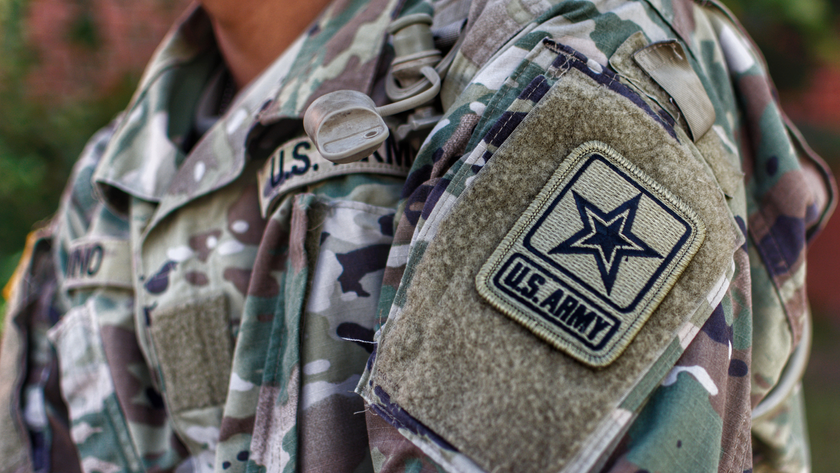The best hiking backpacks: from the lightest daypacks to sturdy alpine haulers
We've tested the best hiking backpacks to see you through all your winter climbing, fastpacking, and mountaineering adventures

- Quick list
- Best all rounder
- Best for hut to hut trekking
- Best daypack for climbers
- Best daypack for versatility
- Best daypack for fast paced adventures
- Best daypack for fast-paced adventures
- Best for winter mountaineers
- Best for winter walkers
- Best entry level expedition pack
- Best budget backpack
- Best for weekend adventures
- Comparison table
- How we test
- How to choose
We've gathered the best hiking backpacks for all your outdoor needs in 2025 and subjected them to rigorous testing to bring you a definitive guide to the finest options available. From large capacity gear haulers and winter-ready packs to fast and light daypacks designed for shorter hikes, we've covered countless miles to put them through their paces
The best hiking backpack for you will depend on your chosen adventures and, to some degree, the season. The depths of winter call for more layers and, if you're venturing above the snow line, mountaineering equipment. This means you'll need more capacity than a standard daypack, ideally upwards of 40 liters.
Likewise, expedition campers will need even more capacity in order to comfortably carry their tents, sleeping bags and camping equipment. Meanwhile, female hikers may prefer the stylings of the best women's hiking backpacks, designed with the female form in mind.
We rate the Gregory Katmai 55 as the best hiking backpack overall, thanks to its stability, comfort and sustainability credentials. However, every pack we feature here is a superb option, so it's important to consider what features and qualities you're looking for in your ideal backpack, before you make your choice.
The quick list
This is our quick list, a brief overview of the best hiking backpacks available today. To find out more about each pack, see our more detailed write ups further down the page in this guide.
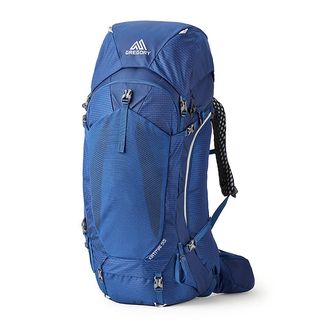
A fully-featured trekking and backpacking rucksack with Gregory’s trademark carrying comfort
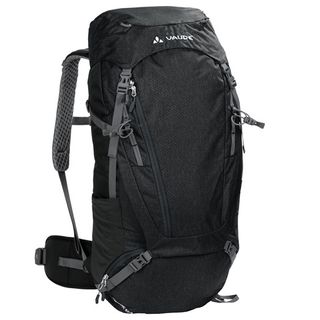
Enough carrying capacity for mountain kit, without the bulk of an expeditionary pack
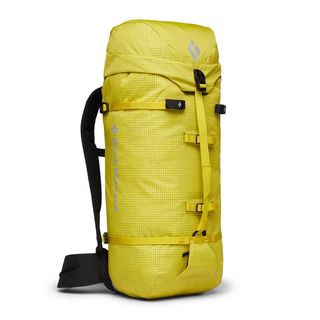
A reliable alpine backpack that combines clever features with easy functionality and sold durability
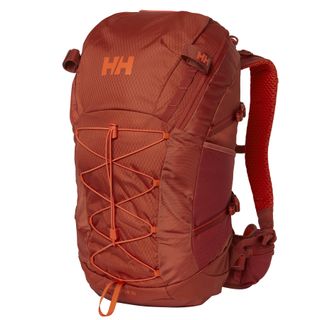
A mid-sized, highly featured daypack that offers a huge amount of versatility
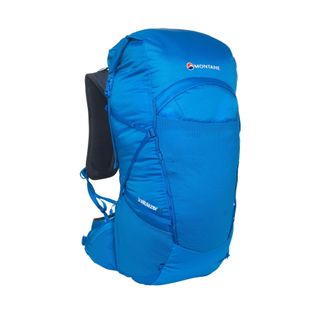
An impressively lightweight and functional pack, with a streamlined design that strips away unnecessary weight
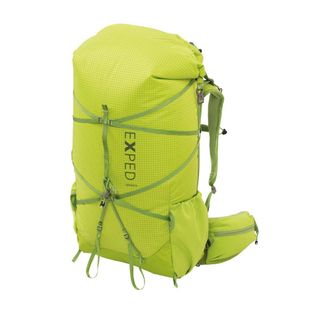
Retains the ethos of functional minimalism that made it so popular with in the first place, while beefing up a range of features
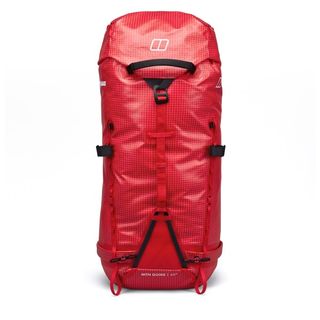
A quality pack with customizable features suited to mountaineering, ski touring and climbing use
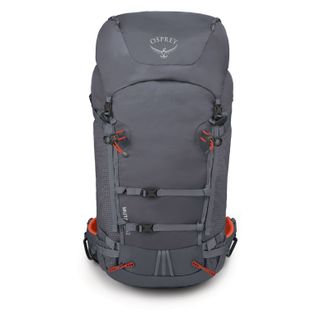
Developed in collaboration some of the world’s greatest climbers and mountaineers, Osprey’s Mutant 52 is a pack designed to meet the demanding needs of alpinists
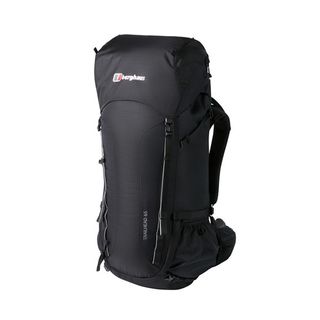
The Trailhead provides everything you need from a hiking backpack at an extremely competitive price.
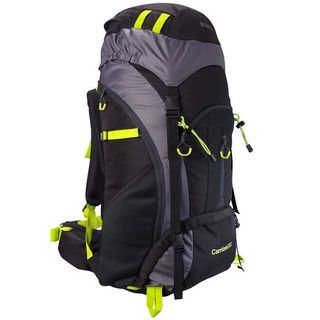
A reasonably priced hiking backpack more than capable of hauling everything you need for an overnight or multiday trekking adventure
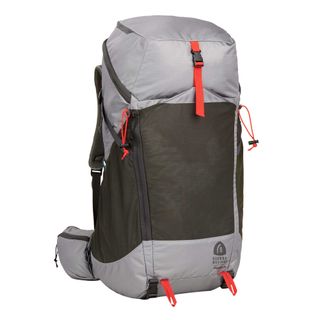
Ideal for overnight and weekend escapades when you just grab a tent and sleeping bag and head off to explore
The best hiking backpacks we recommend in 2025
You can trust Advnture
The best all rounder
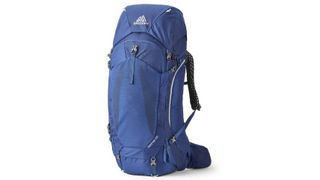
Specifications
Reasons to buy
Reasons to avoid
A fully-featured trekking and backpacking rucksack with Gregory’s trademark carrying comfort, the Katmai 55 has pivoting shoulder straps and a flexible, wraparound hipbelt that kept our hips and shoulders happy, even when we were carrying heavy loads. The suspended mesh back panel delivers good airflow, and has a Polygiene treatment to inhibit odours after long hours hiking on hot, sweaty trails.
The brand has also employed partly recycled fabrics in the pack’s construction and calculated the overall carbon cost of the product (the equivalent of hiking 89 miles rather than taking a car journey apparently), which means you can offset the environmental impact of your purchase via your next long-distance walk or thru-hike. Boasting a profusion of pockets and different compartments, we found the Katmai to be a deluxe gear-hauler for those who like to stay organised on their adventures.
Read our full Gregory Katmai 55 review
The best for hut to hut trekking
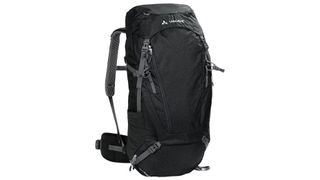
2. Vaude Asymmetric 42+8
Our expert review:
Specifications
Reasons to buy
Reasons to avoid
Multi-day backpacking trips frequently don’t involve tents, sleep mats and all the paraphernalia of self-sufficient overnighting. Networks of huts and hostels, especially in the Alps, allow for long, high-altitude walks with the comfort of a mattress under a solid roof for sleep.
We reckon that the Asymmetric 42+8 is ideal for these types of adventures, with enough carrying capacity for mountain kit, without the bulk of an expeditionary pack. We were able to use the adjustable back system, which saw the shoulder harness slide up and down to achieve a personalised fit, and the padded shoulder straps and hip belt kept the pack close and comfortable throughout our test. There’s a long, flat zipped pocket on the front for a map or jacket, zipped entry to the main compartment and separate pockets in the lid and on the hip belt. The bottom internal compartment can stow dirty kit, or even take a tightly compressed sleeping bag.
The best daypack for climbers
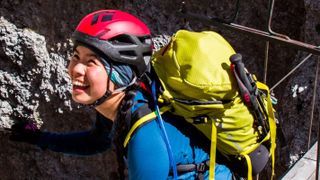
Specifications
Reasons to buy
Reasons to avoid
We found the Black Diamond Speed 30 to be a reliable alpine backpack that combines clever features with easy functionality and sold durability, all of which means it should feature high on any aspiring alpinist’s kit list. It’s low profile and easy to carry without being ultralight or minimalist, and it can be customized according to your mountain exploring and climbing requirements.
It’s one of the best daypacks around for mountain folk who like to head into the high hills all year round. The Speed 30 cleverly combines the light feel and ultra-tough durability of a high-performance alpine-orientated backpack, with a fully strip-downable design – including removable waist belt, lid and frame sheet.
On test, our favorite features included the top-loading hood buckle that’s easily closable, even with hiking gloves on; a draw cord skirt at the top, which is useful for stopping spindrift and snow getting into the pack; and a welded front abrasion patch that protects the pack from jagged rocks and crampons.
Read our full Black Diamond Speed 30 backpack review
The best daypack for versatility
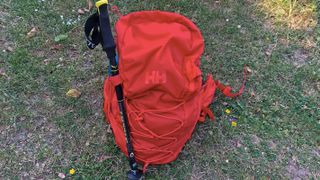
Specifications
Reasons to buy
Reasons to avoid
The Transistor is a mid-sized, highly featured daypack that offers a huge amount of versatility, and can be used for just about any short-length mountain or trail-based activity, from day hiking and mountain biking in the hills and peaks, to scrambling along ridgelines.
The Transistor’s back panel, shoulder straps and hip belts are all made with perforated EVA foam, covered with 3D air mesh, to facilitate ventilation. There is no specific women’s version of the pack, but the harness is adjustable. Having said that, moving the sternum straps tends to be a fiendishly fiddly business, and you can lose the component parts.
It’s the versatility of this pack that really endears it to us. The harness is comfortable, and the hip belts are very substantial and comfortable considering the relatively small size of the bag. We've been using the Helly Hansen Transistor Backpack during all kinds of outdoor adventures during test, with a whole range of hiking and biking trips, as well as an off-road marathon and it performed well throughout.
Read our full Helly Hansen Transistor Backpack review
The best daypack for fast paced adventures
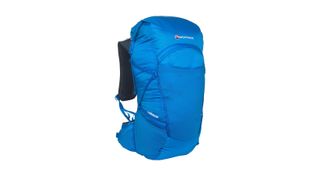
Specifications
Reasons to buy
Reasons to avoid
The Trailblazer 44 is an impressively lightweight and functional pack, with a streamlined design that strips away unnecessary weight. However, it doesn’t skimp on features, with plenty of practical pockets that offered us ample on-the-go storage. The price point is also attractive, and we think this is a great value choice if you’re looking to go ‘fast and light’ on your next adventure.
On test, the simple but effective back system felt stable and comfortable enough with loads of up to about 10kg, and while we found that it perhaps isn’t the most supportive or best ventilated design, it finds a good balance between maintaining a low trail weight and delivering overall carrying comfort. The main compartment is roomy enough to carry a full set of lightweight camping gear, while also being easy to pack and hydration compatible.
Read our full Montane Trailblazer 44 review
The best minimalist daypack
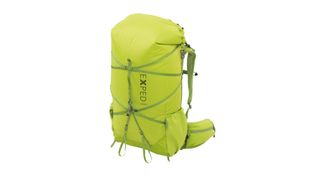
Specifications
Reasons to buy
Reasons to avoid
The latest version of this tried-and-tested pack retains the ethos of functional minimalism that made it so popular with lightweight backpackers in the first place, while beefing up the pack’s overall durability, load-hauling ability and carrying comfort. With an adjustable torso length and various customisable and removable options too, we found it to be a versatile beast for trips ranging from a few days to a few weeks.
The top-loading, roll-top design saves weight, and while it made access to the roomy main compartment slightly fiddly, that is largely offset by the useful deep outside top pocket, twin stretch side pockets and zipped hip belt pockets. For a minimalist pack, it's very stable when fully loaded and we found it comfortable to carry too, with ample shoulder and hip padding as well as plush lumbar support.
Read our full Exped Lightning 45 review
The best for winter mountaineers

Specifications
Reasons to buy
Reasons to avoid
A quality pack with customizable features suited to mountaineering, ski touring (though it's not a dedicated ski backpack) and climbing use. On test, we found that, whether heading to a crag for a spot of single pitch trad climbing, scrambling in the fells or heading somewhere snowy, the ability to adapt and remove the pack's various fixtures depending on what we were doing was a real boon.
Meanwhile, the build quality and materials mean it should last for countless adventures. The main fabric, made from 100% recycled 400 denier nylon with a dope-dyed polyester ripstop, feels tough as old boots and is crinkly to touch.
Being part of the ‘Guide’ pillar of Berghaus’ Extrem range, it’s aimed squarely at serious mountaineers, so it lacks some of the features more casual hikers might value, like easily accessible mesh pockets, a vented back system and hipbelt pockets.
Read our full Berghaus MTN Guide 45+ review
The best for winter walkers
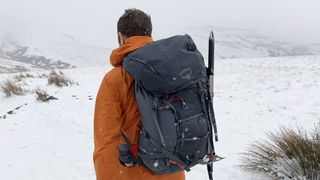
Specifications
Reasons to buy
Reasons to avoid
Developed in collaboration some of the world’s greatest climbers and mountaineers, Osprey’s Mutant 52 is pack designed to meet the demanding needs of alpinists. Blending the long-distance carry capabilities of a mountaineering pack with the fast and light ethos of the Mutant series, it’s a versatile pack that can be used for a range of adventure styles through the year.
Safety, stability and comfort were three of the main design goals. On test, we found the Mutant has a noticeably slim profile to aid stability and a close-to-body fit. It very much felt like a part of us once we were out in the wild, while still having all the attachments we needed for items like ice-axes, skis, ropes and helmets.
Where winter mountaineering and alpine exploits are concerned, the Mutant hits the sweet spot. It’s got enough capacity for all you’ll need – as well as clever storage solutions for the pre-requisite kit – while retaining the lightweight, streamlined and durable qualities of the smaller Mutant packs.
Read our full Osprey Mutant 52 review
The best entry level expedition pack
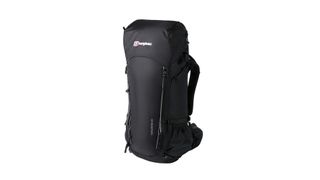
9. Berghaus Trailhead 65
Our expert review:
Specifications
Reasons to buy
Reasons to avoid
The Trailhead provides everything you need from a hiking backpack at an extremely competitive price. It fits a wide range of sizes and we were able to tinker with the adjustable BIOFIT back system, which slides from S to XL to position the harness according to height. There’s also a good amount of space between the shoulder and upper back pads to create a through-flow of air.
A ‘diaphragm’ gave us the option of creating one open main compartment or to split it into two – one for clean kit, perhaps, and one for wet or dirty gear. We liked the way that this compartment s accessible from both the top and from a zip that runs down the front of the pack. Side pockets swallow a map and bottles, while the lid has a pocket large enough to fit a waterproof jacket. There are also external loops to attach walking poles, a channel for a hydration bladder hose, and a rain cover, so pretty much all bases are covered.
The best budget backpack
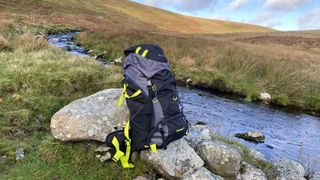
Specifications
Reasons to buy
Reasons to avoid
This reasonably priced hiking backpack is more than capable of hauling all the gear you need for an overnight or multiday trekking adventure. The large, extendable main compartment has a double toggle closure system and it can be accessed from the top, or via a zipped side pocket, which is really useful for finding inadvertently buried items when you suddenly realise that you need them while out in the wilds. There is a multitude of pockets on the Carrion, including two in the hood (one on the inside and one on the outside), a large pouch in the front and a pair of good-sized pockets on the hip wings – all of which zip shut. In addition, there are bottle-carrying pouches on either side of the pack, plus an inner pouch for carrying a hydration bladder (although, annoyingly, there’s no hook to hang the reservoir from), and a portal for the hose on the right shoulder.
On the outside of the pack you’ll find straps for carrying trail tools such trekking poles and ice axes, and various hoops and loops that can be used to hang torches and other items from. There are compression straps on the side, too, that not only let you keep the contents of the pack well contained, but can also be called into action to help hold items such as closed-cell camping mates in place.
The Carrion comes in one size only, but the harness can be raised or lowered quickly and easily. The waist belt is wide and comfortable, incorporating two wings to help seat the backpack properly on your hips, and the sternum strap is easily adjustable. Two shoulder wings keep the pack proud of your back (slightly), to allow some airflow and cut down on sweating. The main straps are made with a mesh outer fabric to facilitate some ventilation as well, and they’re well padded for greater comfort. Pleasingly, the Carrion comes with a rain cover, which is located on the bottom of the pack.
The best for weekend adventures
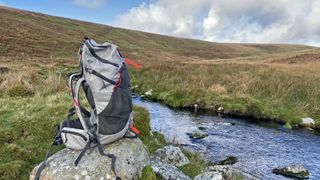
Specifications
Reasons to buy
Reasons to avoid
With an internal frame, plenty of carry capacity, a well-padded back and a comfortable harness, this 60L pack from US brand Sierra Designs is ideal for overnight and weekend escapades when you just grab a tent and sleeping bag and head off to explore a hill, mountainside or moor. However, the Gigawatt offers extra carry options that make it usable for much longer adventures. The main compartment is generous, and access is excellent. There’s a super wide zipped opening at the top, and one of our reviewer’s favourite features on this pack is the side-access zipped opening, which allows you to find items that have been buried deep in the pack without emptying the rest of the contents all over the trailside.
Inside there is pouch (and hook and hose portal) for a hydration bladder, but otherwise the main compartment has no dividers. However, several external pockets allow you to organise gear efficiently, including three oversized external mesh pockets that can be used to store extra layers and gear such as hiking gloves, waterproof jackets and rain pants, that you might need to access quickly. There is also a large zipped pocket on the lid, with a sub-pocket inside, also with a zip, for keeping important things such as car keys somewhere secure and easy to find. The pack’s hip wings feature extra-generous zipped pockets, too (although, on test, one of these zips unfortunately failed).
The zip closure on the main compartment (as opposed to a more common cord-and-toggle closure system) make it impossible to pull the top tight, but external compression straps mean you can keep the bag compact even when it’s not full, and these double as lash points to help secure extra gear (such as trekking poles and ices axes) to the outside of the pack (there are material hoops at the bottom of the pack for this purpose too).
This pack is only available in one size, but the harness can be adjusted and secured in the right place for people with back lengths of between 16 and 21 inches, by using Velcro fasteners (although it is a little fiddly to get this right). The padding on the back panel is comprehensive and comfortable, with a contoured design to allow some airflow. Both the back panel and the shoulder straps are constructed with a breathable mesh on the side of the fabric that comes into contact with your body, to cut down on sweatiness. There is a good, easily adjustable sternum strap and the hip wings are substantial, allowing you to spread the weight of the pack properly. The waist belt is wide and comfortable, and it can be adjusted at four points for a really good fit.
Best hiking backpacks comparison table
Hiking backpack | Price | Weight | Style | Best use |
Gregory Katmai 55 | $260 (US) / £210 (UK) | 2.12kg / 4lb 10.9oz | Standard hiking backpack | Hiking, light backpacking, mountaineering, hut-to-hut trekking |
Deuter Trail Pro 36 | $165 (US) / £130 (UK) / €170 (EU) | 1.49kg / 3lb 7oz | Day pack | Hiking, hut-to-hut trekking, mountaineering |
Vaude Asymmetric 42+8 | $180 (US) / £150 (UK) / €160 (EU) | 1.475kg / 3lb 7oz | Standard hiking backpack | Hiking, light backpacking, mountaineering, hut-to-hut trekking |
Black Diamond Speed 30 | $185 (US) / £140 (UK) | S-M 990g / 2lb 3oz; M-L 1,140g / 2lb 6oz | Mountaineering daypack | Climbing, scrambling, mountaineering and high-altitude hiking |
Helly Hansen Transistor Backpack 30L | $170 (US) / £150 (UK) | 775g / 1lb 11oz | Daypack | Day hiking, biking, running, scrambling, peak bagging, climbing and all sorts of one-day trail-based pursuits |
Montane Trailblazer 44 | £110 (UK) | 980g / 2lb 2.6oz | Day pack | Speed hiking, fastpacking, hut-to-hut trekking |
Exped Lightning 45 | $100 (US) / £170 (UK) | 1164g / 2lb 9oz | Day pack | Speed hiking, fastpacking, hut-to-hut trekking |
Craghoppers Classic Rolltop Backpack 20L | $73 (US) / £55 (UK) | 645g/ 1.42lb | Small day pack | Speed hiking, urban uses |
Berghaus MTN Guide 45+ | £220 (UK) / no US price currently | 1.67 kg / 3lb 6.8oz | Mountaineering pack | Alpine and winter mountaineering, winter walking, ski touring |
Osprey Mutant 52 | $225.00 (US) / £180.00 (UK) / €200.00 (EU) | 1.5kg / 13 oz | Mountaineering pack | Alpine and winter mountaineering, winter walking, ski touring, wild camping |
Berghaus Trailhead 65 | £110 (UK) / €180 (EU) | 1.7kg / 3lb 12oz | Expedition backpack | Hiking, backpacking, mountaineering, hut-to-hut trekking |
Mountain Warehouse Carrion 65 | £119.99 (UK) | Row 12 - Cell 2 | Expedition backpack | Hiking, backpacking, mountaineering, hut-to-hut trekking |
Sierra Designs Gigawatt 60 | £129.99 (UK) / $149.95 (US) | 1.84kg / 4lb 0.6oz | Expedition backpack | Hiking, backpacking, mountaineering, hut-to-hut trekking |
How we test the best hiking backpacks
Our reviewers test hiking backpacks on trails in a range of environments and conditions, carrying various weights, ranging from multiday loads to day provisions. Features (including design, carry capacity, harness comfort, product weight, materials, pockets and ease of access) are tested against claims made by the brand, and we assess factors such as value for money, durability and functionality.
For more details. see how Advnture tests products.
Meet the testers

Matt Jones has been testing kit in the field for nearly a decade. Having worked for both the Ramblers and the Scouts, he knows one or two things about walking and camping, and loves all things adventure, particularly long-distance backpacking, wild camping and climbing mountains. He’s based in Snowdonia and last year thru-hiked the Cambrian Way, which runs for 298 miles from Cardiff to Conwy, with a total ascent of 73,700 feet – that’s nearly 2½ times the height of Everest.

Writer, editor and enthusiast of anything involving boots, bikes, boats, beers and bruises, Pat has spent 20 years pursuing adventure stories. En route he’s canoed Canada’s Yukon River, climbed Mont Blanc and Kilimanjaro, skied and mountain biked through the Norwegian Alps, run an ultra across the roof of Mauritius, and set short-lived records for trail-running Australia’s highest peaks and New Zealand’s Great Walks.

Alex is a freelance adventure writer and a qualified mountain leader with an insatiable passion for the high places. The fells of his native English Lake District has a special place in his heart, though he is at least equally happy in North Wales, the Scottish Highlands or the European Alps. He's currently President of the London Mountaineering Club and working towards his winter mountain leader qualification.

A former brand ambassador for Merrell and current Ordnance Survey #GetOutside Champion, Jessie Leong’s lifelong outdoor odyssey began with Duke of Edinburgh’s Award walks in the Peak District. This segued into long hill hikes in the Yorkshire Dales, multi-day treks in the Lake District, scrambles in North Wales and adventures scaling alpine pinnacles. When not walking, she can be found rock climbing, wild swimming, cycling, photographing, filmmaking, writing and modelling.

After spending a decade as editor of Country Walking, the UK’s biggest-selling walking magazine, Jonathan moved to edit Outdoor Fitness magazine, adding adrenaline to his adventures and expeditions. He has hiked stages or completed all of the UK's national trails, but was once overtaken by three Smurfs, a cross-dressing Little Bo Peep, and a pair of Teletubbies on an ascent of Snowdon. (Turns out they were soldiers on a fundraising mission.)
How to choose the best hiking backpack
There's an almost overwhelming choice out there when it comes to choosing the best hiking backpack. With such a range of sizes, features and applications, it can be difficult to know where to begin. Below, we've included some frequently asked questions and guide you through the main feature considerations when choosing a hiking rucksack.
Before investing in the best backpack for you, consider the following...
What's the difference between a hiking backpack and a standard backpack?
A standard backpack is designed for everyday, urban life, often with compartments for items like laptops and other electronics. Generally, this kind of backpack will have a capacity akin to a small daypack and won't be designed to haul heavy loads. As the wearer may be wearing it to places like the office or the shops, style and sophistication are serious considerations. Comfort is important too, though these kinds of packs aren't intended for continued wear for hours and hours and its probable that the wearer won't be exerting themselves too much while wearing it. While they have to be resistant to the weather to some degree, this isn't as crucial as on a hiking backpack.
A hiking backpack has much more to deal with than a standard backpack. For a start, it's likely the wearer will be shouldering it for several hours while on the trail, so it has to be super comfortable. It's also likely that the wearer will be working up a sweat, which makes air flow a crucial component too. This is why hiking backpacks often have ventilated back systems and the additional support of chest straps and hip belts, which transfer much of the weight of the pack off the shoulders, making for a more comfortable carry experience.
Speaking of weight, hiking backpacks are designed with durable fabrics that allow them to carry plenty of stuff. Super strong nylon is usually used for the main body, as it is also resistant to rock abrasion and the weather. Other features you'll often see on hiking backpacks that you typically wouldn't on a standard backpack include attachments for trekking poles and ice axes, integrated emergency whistles, a compartment for a hydration bladder, reflective detailing and a waterproof cover, among others.
They also tend to have an interior frame that transfers the weight to your lower body. Back in the day, external frames were fairly commonplace but these days they've been replaced with lighter, form-hugging interior frames.
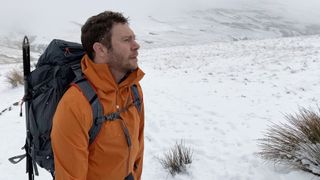
Capacity
The approach you take to your hiking adventures will determine the size of backpack you'll need. Bigger packs are designed with camping expeditions in mind and come with all kinds of innovative storage solutions for items like your tent. Medium-sized packs are built with day-long adventures in mind and may have features like trekking pole or ice axe attachments. Smaller daypacks start to cross into hydration pack territory and feature handy pockets for things like water packs.
If you're looking to take to easy trails in just your best hiking shoes rather than full on boots, you won't want a heavy expedition pack. Likewise, if you're off an an epic thru-hiking adventure, where you'll be carrying all your camping gear from place to place, the best hiking backpack for you will have plenty of capacity.
As a rough guide, smaller packs for lightweight day walks range between around 15 and 35 litres. Medium packs, ideal for hut-to-hut treks or longer days scrambling and hiking in the mountains range from 35 to 55 litres. Above 55 litres and you're into serious expedition territory, with the capacity you need for your tent and camping gear.
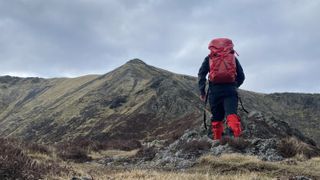
What size backpack is suitable for a 5-day hike?
For a 5-day hike, you'll be carrying your camping tent, sleeping bag, other camping equipment, spare clothes and plenty of food too. It depends slightly on the packability of your gear but for a 5-day expedition, we'd recommend a backpack with a capacity upwards of 60 liters.
What size backpack is suitable for an all-day hike
This really depends on the season. In summer, when there's a good weather forecast, some people hike with nothing more than a hydration pack. However, if you're out on the trails all day, you'll probably need a decent sized daypack, upwards of 20 liters.
When it comes to the colder months, your carrying needs increase, as you'll need space for warm layers, a blizzard bag and perhaps additional food and a hot drink. If you're winter walking, you'll also need an ice axe attachment and space for your crampons and possibly a helmet depending on where you're heading. Backpacks designed for winter tend to have a capacity of 40 liters and up.
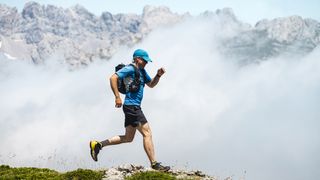
Back system
How the best hiking backpacks sit against your spine can make all the difference to your comfort and confidence on tracks and trails. Most back systems have some sort of padding to protect your spine from the pack, while deep grooves create air channels that allow sweat to evaporate.
Other designs deploy a mesh trampoline that holds the entire back away from your spine for even greater breathability and support. This can, however, compromise your balance by holding the weight of your pack further away from your back. If you're weighed down by your camping gear, a traverse of technical ground becomes more difficult with such a backpack.
Harness
Shoulder straps need to hug your body closely, sharing the weight of a backpack with the hip belt. This is one of the areas where female hikers will find women-specific backpacks with shaped straps more comfortable. Shoulder straps themselves come in different widths and with more or less generous padding – it’s a personal choice between comfort and weight.
Some straps also feature a small pocket or hooks on which to hang kit, ideal for items like your compass or multitool. This particularly true on hydration packs designed for adventure runners, who want to be able to grab energy gels and hydration pouches on the go.

Hip belt
Much of the weight of a backpack is supported by the hip belt, which hugs the core of your body. After a long day in the mountains, a standard hip belt often leaves your sides feeling a bit raw. The best hiking backpacks are designed to alleviate this issue. A bit of cushioning here can make a big difference to comfort, and a hip belt pocket for phone, GPS device or other items of hiking technology can prove to be very handy, especially with quick navigation in mind. Some hip belts on larger backpacking rucksacks are designed to swivel with your body movement as you walk, boosting your balance.
Organisation of gear
The fundamental purpose of the best hiking backpacks is to carry kit, so how it distributes this gear is vitally important. How to pack a backpack depends on personal preference. Some walkers (and especially climbers) prefer a tall slender pack, with few external pockets and kit carefully stowed in different coloured stuffsacks inside. Other walkers appreciate a host of lid and side pockets for frequently accessed items, such as drinks, snacks, camera and credit card, while keeping extra layers of clothing and a stove in the main compartment.
It’s entirely a question of personal choice, but make sure you choose a backpack with a volume large enough to accommodate all your hiking paraphernalia, from your best hiking gloves and hats to your binoculars and insect repellent. Be aware, however, that just because you have space for extra kit doesn’t mean you should take it – lugging unnecessary gear up and down mountains is a thankless task.
Access
This is particularly important in winter. Fumbling with frozen fingers to open a backpack is a huge frustration, so check you’re happy with the access points. Do they open widely enough? Are the drawcord or zips easy to use, even with gloved hands? Does a top opening work for you or would you prefer a full-length zip along the pack to give instant access into the depths of your bag?
When backpacking in winter conditions, a good tip is to pack away things like your best down jacket and waterproofs unzipped, so that when you grab them from your pack, you've got one less thing to fumble with. Little efficiencies like this mean that you spend less time standing still and more time moving — crucial in the harsh winter environment.
Dealing with the weather
Your backpack is going to get wet. This is a fact. Very few backpacks are built to be fully waterproof and those that are can be eye-wateringly expensive. If you know you are going to be out a lot in the wetter seasons, it may be worth splashing out.
Even many of the best hiking backpacks are merely water resistant, which means they will cope with the occasional shower but succumb to longer spells of persistent rain. Most come with an elasticated waterproof cover that can be slung over them when the weather takes a turn for the worse. However, these rarely keep things totally dry.
With this in mind, many experienced hikers use dry bags to not only keep their kit dry, but also compartmentalize. This is particularly useful if you are on an expedition, where you can use one dry bag for wet kit, one for dry clothes, one for sleeping essentials and another for valuables.
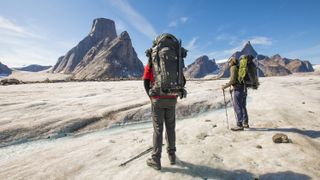
Advnture Newsletter
All the latest inspiration, tips and guides to help you plan your next Advnture!
An outdoors writer and editor, Matt Jones has been testing kit in the field for nearly a decade. Having worked for both the Ramblers and the Scouts, he knows one or two things about walking and camping, and loves all things adventure, particularly long-distance backpacking, wild camping and climbing mountains – especially in Wales. He’s based in Snowdonia and last year thru-hiked the Cambrian Way, which runs for 298 miles from Cardiff to Conwy, with a total ascent of 73,700 feet – that’s nearly 2½ times the height of Everest. Follow Matt on Instagram and Twitter.
- Jessie Leong
- Pat KinsellaAdvnture Consulting Editor
- Alex Foxfield
- Louis Dzierzak
- Jonathan Manning


